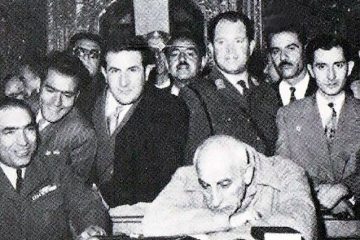A Look at the Unfinished Journey of the Passengers from Iran Air Flight 655
The first missile strike on a passenger plane dates back to July 3, 1988. The world’s news agencies wrote about this incident: Iran Air Flight 655, which was traveling six and a half miles across the island of Hengam, was shot down by the Vincennes with two missiles 2MR-SM. Admiral William Fogarty, in a report released as the official investigation into the downing of Iran Air, supported Captain Rogers as the Captain of the Vincennes warship, citing misinformation as the main reason for the shooting.
At the time, American ships were active in the Persian Gulf waters, and light skirmishes with Iranian artillery and speedboats were taking place. Apart from this, American helicopters also came under fire from Iranian planes, which created a semi-combat atmosphere for the Vincennes. The movement of the Iran Air passenger plane in the midst of the uproar of the war, led to the perception that a fighter jet from Iran was attacking the ship. This case was confirmed by surveillance radars, which also revealed the identity of a military aircraft. Captain Rogers’ interpretation of the downing of the passenger plane was a sense of responsibility for a war situation. He also believed that his team was focusing on Iranian speedboats that surrounded the ship and knew the identity of the aircraft in just four minutes, and since they were also in charge of guarding the USS Elmer Montgomery, they had to Make the most sensible decision in no time.
Despite the remarks of Captain William C. Rogers III, the second commander of the Vincennes, the American media denied his explanations and also Admiral Fogarty’s report access by as well as the remarks and so independent research continued. Newsweek’s John Berry and Roger Charles found it almost impossible to make a radar error, given the Vincennes’ capabilities. Since the Vincennes was one of the only five launched warships to carry the Aegis system, it used an integrated computer combat management system with an advanced AN/SPY radar with automatic, multi-purpose, and time-based automatic tracking. Therefore, the miscalculation of the Vincennes radars was unacceptable, and this is just a kind of cover-up on the issue by US officials.
The initial reaction of the US military officials to the incident was in support of Captain Rogers. At that historical juncture, the US Department of Defense, in its first response to the declining flight frequencies of Iran Air, described such frequencies as specific to military flights. According to the US Department of Defense, due to the down frequencies of the passenger plane, there was a possibility of a military attack on the Vincennes, and Captain Rogers made the most logical decision in the shortest possible time. However, the same report was denied a few months later by the US Department of Defense. Exactly a few months after the incident, the acknowledgment of the upward movement of the Iran Air passenger plane caused the issue to be covered by the media again.
The media psychological pressure on Captain Rogers was largely due to the presence of the Vincennes in Iranian waters and the ship’s aggressive attacks on Iranian boats, which even drew criticism from some American officers. In this regard, the commander of the USS Sides, David Carlson, as the second ship under Rogers’ tactical control, attributed the downing of the passenger plane to his fighting spirit and aggression. One of Rogers’ critics, Carlson protested in July 1988 against the firing of a ship on Iranian boats. Carlson believed that because of the high cost of the warship, shooting boats at first with battleships belonging to the battle group was not a rational thing to do, and that the reason for these shots by Rogers was his adventurous spirit.
Long after the incident, the BBC revealed in a documentary “Another Lockerbie”, a psychological complication called the challenges of education. Challenges of training are in fact unconscious behaviors that officers encounter during military challenges under the influence of military training. According to this documentary, the crew of the Vincennes and his commander, under the influence of the same training, fired at the plane immediately after seeing it, and had no verification of the existence of a military or passenger plane.
One year after the downing of an Iranian airliner, Rogers resigned on May 27, 1989, and in 1990 was awarded the Legion of Merit by George W. Bush for his outstanding performance. The American media had conducted various interviews with George W. Bush’s father over the years following the incident, but he stressed in an interview with Newsweek that he would never apologize for the United States’ actions and would have nothing to do with the facts.
The firing of the Vincennes ship killed 290 Iranian passengers on board of the Iran Air plane, and their images on the waters of the Gulf caused panic among the people of the world. “I will carry the burden of this (attack on the Iranian plane) for the rest of my life,” Commander Rogers said in a key sentence.
Source
Storm Center: The USS Vincennes and Iran Air Flight 655: A Personal Account of Tragedy and Terrorism, William Rogers (1992)



0 Comments